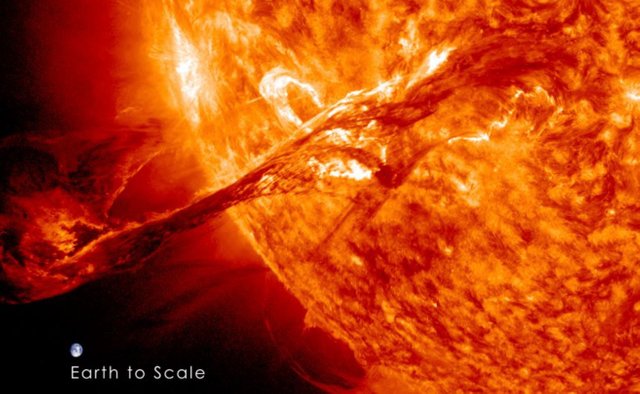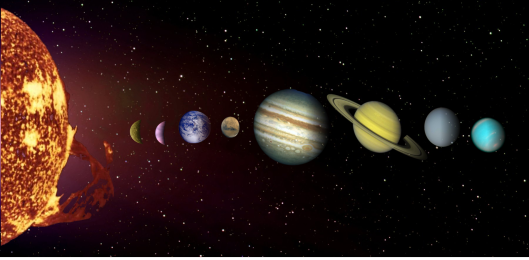50 Facts About Our Solar System that will leave you speechless. Part 1...!
Our solar system is made up of the sun and everything that moves in orbit around our star; planets, dwarf planets, moons and spatial rocks.
Astronomers believe that the brink of our solar system is about 15 billion miles away from our Sun.
The planets of our solar system have been an object of tremendous interest to ancient civilizations over thousands of years. There are thousands of things that few people know about our solar system, in this article we will present you some interesting facts:
1. According to astronomical studies, our sun was created 4.6 billion years ago by the gravitational collapse of a giant molecular cloud.
2. Our sun needs 240 million years to complete a single orbit around the center of our Milky Way galaxy.
3. According to astronomers, since our Sun was formed, he has performed nineteen orbits around the galactic center.
4. Do you know that our star, the Sun, rotates in the opposite direction of clock clocks?
5. The surface temperature of our Sun is about 5505 degrees Celsius
6. Since its formation, our Sun has used about half of the hydrogen in its nucleus. That means there is still plenty of fuel to burn, so do not worry.
7. Much of the magnitude of the solar system is within the Sun, ie over 99 percent, while the remaining mass is found in Jupiter.
8. According to astronomical calculations, the magnetic field of Jupiter is about fourteen times stronger than that of the Earth.
9. Do you remember the big storm in Jupiter? Well, this giant storm is one of the greatest mysteries of astronomy. Experts do not have almost any information about it. Everything about it is a mystery. What power did it have, what caused it, and why is it red?
10. Did you know that the red spot on the surface of Jupiter is actually an anti-cyclone storm? It is believed that it started about 300-400 years ago.
11. Solid solar system objects; planets, moons, etc., account for 0.0001% of the total mass of the Solar System.
12. Although our Sun is giant, it is small if compared to VY Canis Majoris; a red supergigand set in the Canis Major constellation. This star is so big that if it is placed in our Solar System, the surface of VY Canis Majoris would extend beyond the orbit of Jupiter. VY Canis Majoris is so great that astronomers estimate it's 1,000,000,000 times bigger than our sun.
13. Did you know that Jupiter saved the Earth? Comet Lexell was traveling to the Earth after a trajectory that would make it crash on our planet. However, thanks to Jupiter's strong gravitational attraction, the comet pulled toward this planet.
14. Our sun consists of about 98% hydrogen and helium.
15. We practically live within our Sun. This is because the outer atmosphere of the Sun extends far beyond the visible surface; it's extraordinary. Toxic to orbit, in this subtle atmosphere.

16. Practically, the Sun can spill a million Earths.
17. As many of us have probably learned in school, the distance from the Sun to Earth is a Astronomical Unit or AU.
18. The heliosphere, which is the outer atmosphere of the Sun, is thought to extend to about 100 Astronomical Units; The Astronomical Unit is equal to 149 597 871 kilometers.
19. Scientists suggest that the heliosphere boundary, referred to as Heliopause, is located fifteen billion miles away from our Sun.
20. Experts believe that the sun's atmosphere lies billions of miles below, because they believe that the Sun's atmosphere actually has a "lot" shape.
21. Compared to the rest of our solar system, the mass of the Sun is only one trillion percent of the entire volume of our solar system.
22. Astronomers believe that within our solar system there are more than ten thousand objects that can be large enough to be rounded by their gravity.
23. If we were to see the universe from an external point of view, we would see that our solar system is located on the Orion arm, which is about 26,000 light years away from the center of our Milky Way galaxy.
24. As you already know, there are eight planets in our solar system, but there are hundreds of unidentified objects that are located in the distant part of our cosmic "neighborhood."
25. The moon is considered to be the closest astronomical object to Earth. Why did not we visit it more often?
26. Of the eight planets in our solar system, Mercury, Venus, Earth and Mars consist mainly of rocks and metals. And there is a missing planet between Mars and Jupiter.
27. Jupiter, Uranus, Neptune and Saturn are mainly composed of hydrogen and helium. They are the Gigantic Giant.
28. According to astronomers, Neptune has the fastest winds in the Solar System. Winds on Neptune's surface can reach up to 2100 kilometers per hour. Scientists have not yet determined the reason.
29. Uranus is the coolest planet in our solar system with temperatures that may fall to -224 degrees Celsius.
30. Jupiter is the fastest planet in our solar system. Jupiter takes less than ten hours to complete a full rotation around his axis.

31. Comets are commonly called "Dirty Snow Balls" because of their composition, ice and rocks.
32. According to astronomical observations, there are 176 known natural satellites coming to orbit around the planets in our solar system, of which 168 satellites orbits planets full scale. 8 moons orbiting twin planets.
33. Jupiter is the planet that has the greatest amount of moons; a total of 63 confirmed satellites have been discovered, and some astronomers argue that there may be even more, wiping around the gas giant.
34. Jupiter, being the largest planet in our solar system, is considered to have the largest ocean in the solar system; astronomers believe it is approximately 40,000 km.
35. Astronomers have discovered some objects that come in orbit around the sun, which are far more far than Pluto. Such an object is believed to be Planet X, a theoretical planet that must be somewhere there, but astronomers have not yet found it.
36. The Kuiper Belt is one of the two major commodity reservoirs and is believed to extend to more than fifty astronomical units. Astronomers also consider it as one of the most remote regions of our solar system.
37. New Oort's Comet is believed to extend to 50,000 Solar Astronomical Units.
38. Astronomers estimate that the Oort cloud contains trillions of icy bodies.
39. According to experts, at the outer edge of the Oort cloud, distant cosmic bodies are believed to have more gravitational influence from their nearby stars than from the Sun.
40. Saturn can actually "swim", but only partially, as Saturn's overall density is 0.69 - seventy percent of water density.
41. Saturn is not the only planet that has rings, Jupiter, Uranus and Neptune also have beautiful rings.
42. Jupiter's dark rings are mostly composed of dust particles and are therefore very difficult to detect. Astronomers believe that within these rings are particles extracted from the volcanic moon of Jupiter, "Io".
43. Astronomers have found that Uranium ring system is similar to Jupiter, although the Uranium ring system content consists mainly of a material produced by the relatively small "satellites" shocks.
44. Saturn is delightful. In fact, the planet has another giant ring, discovered in 2009; it can only be seen through infrared rays.
45. Did you know that the favorite planet of the Solar System, Pluto, was accidentally discovered in the 1930s after astronomers noticed minor and unexpected changes from Uran's predicted orbit and decided to look further; so Clyde Tombaugh discovered Pluto.
46. Pluto was considered the ninth planet of our solar system for seventy-six years, was reduced to a dwarf planet and was our most favorite dwarf planet since 2006.
47. Pluto is extremely small. Researchers estimate that Pluto is just over 2,253 kilometers, smaller than the United States.
48. Despite the fact that Mercury is the closest planet to orbit around the Sun, it is no longer hot. Due to the fact that Mercury has no atmosphere, there is nothing to keep the sun's heat on this planet.
49. According to astronomers, the most hot planet in our solar system is Venus. The second planet closest to the Sun has a very thick atmosphere; astronomers value it to be a hundred times thicker than the Earth's atmosphere. Because of this, massive amounts of heat from the Sun are kept on planets and astronomers estimate that the average Venus temperature is above 468 degrees Celsius. This makes Venus exploration really difficult.
50. Although Mercury is the closest planet to the Sun, researchers believe that ice can be found near Mercury poles.


Thank you very much to every single follower and all steamians who support me.
Also big thanks goes to @busy.org & @busy.pay for huge support to minnows like me and so many other minnows of the steemit community .
So join https://busy.org and lets make steemit community better together.
You can also join me at: https://busy.org/i/@helamia
Take some time to check more of my blogs. You might find something that interests you or learn something new. Best regards from @helamia .
If you wish to contact directly or just want to add me. Follow the links below where u can add / follow me:
https://web.facebook.com/Hilmi.Bojaxhiu
https://www.instagram.com/hilmibojaxhiu/
https://twitter.com/HilmiBojaxhiu
You got a 35.38% upvote from @bid4joy courtesy of @helamia!
You got a 30.53% upvote from @cabbage-dealer courtesy of @helamia!
Earn daily rewards by delegating to @cabbage-dealer.
You got a 100.00% upvote from @stef courtesy of @helamia!